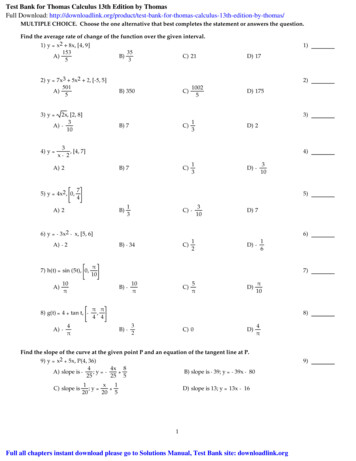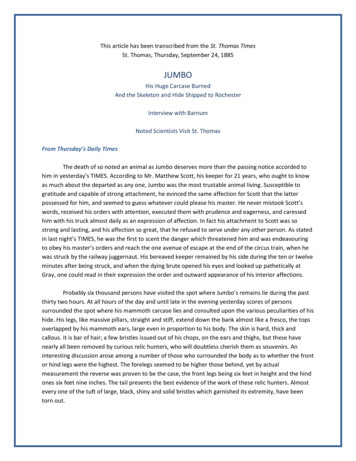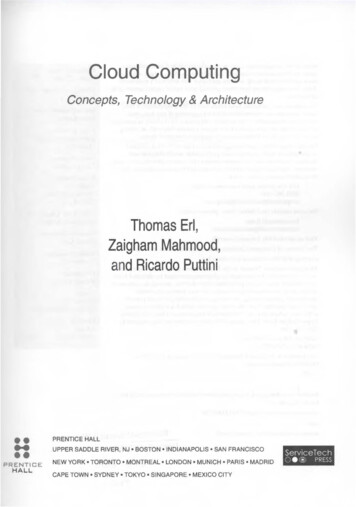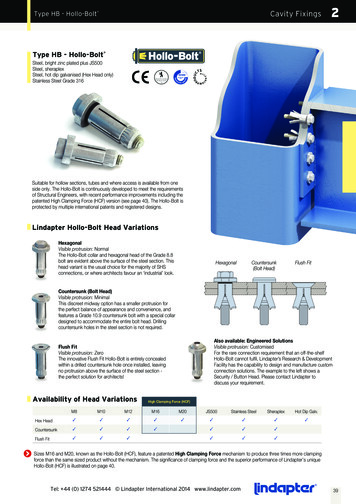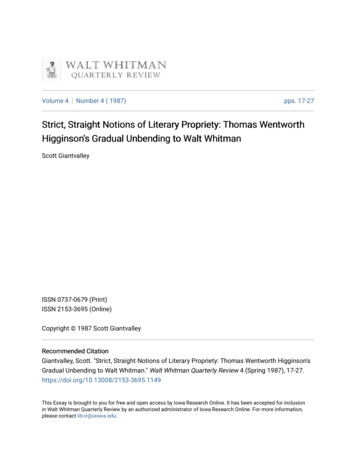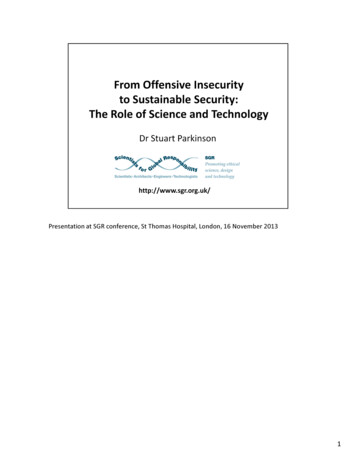
Transcription
Presentation at SGR conference, St Thomas Hospital, London, 16 November 20131
2
Other SGR activities include education work – including presentations to academics, peacecampaigners, and students; articles in specialists media etc – and advocacy work with SGRmembers and other campaign groups on issues related to military involvement in R&DReports listed in references3
Policy shift seen in National Security Strategy and Strategic Defence and Security Review –both in 2010 Detailed military R&D data using freedom of information (FOI) requests Detailed civilian R&D data from publicly accessible databases and FOI requests Parkinson et al (2013)4
5
UK military budget was 60.8 bn in 2012 – world’s 4th largest behind USA, China andRussia UK military spending per person: more than 2 times that of Russia; more than 10 timesthat of China UK spending per person/ per unit GDP is much larger than EU average UK nuclear weapons stockpile being reduced to 180 warheads (see later) UK is home to world’s 3rd largest arms company – BAE Systems UK is 6th largest arms exporter behind USA, Russia, Germany, France and ChinaMain references: Stockholm International Peace Research Institute (2013); Parkinson et al(2013)6
Parkinson et al (2013)7
Destructive area/ capability especially if very little ability to discriminate between soldiers and civilians nuclear weapons especially highRange ability to strike outside UK or NATO’s borders Typhoon’s recently modified to carry out long-range ground strikesMobility ability to be easily deployed effectively outside UK’s borders aircraft carriers especially mobileUse in overseas operations plays an integral role in active overseas conflict includes specialist long-range transport such A400M’sSome allowance can be made for limited use in peace-keeping operationsParkinson et al (2013)8
Nuclear armed submarines Each warhead has explosive power of 100 kilotonnes TNT (8 times Hiroshimabomb) Each submarine can carry up to 40 warheads (4 million tonnes TNT) Final decision on replacement of Trident system (‘main gate’ decision) to be takenby Parliament in 2016Parkinson et al (2013)9
Aircraft carriers 1 aircraft carrier (Illustrious) shortly to be decommissioned; no current capabilityfor carrying planes 2 QE to be the largest ships ever deployed by the UK Navy (3 times the size of theprevious carriers); only 1 QE to be deployedStrike planes Tornado slowly being phased out Typhoon (Eurofighter) recently modified for ground attack; numbers beingincreased F-35 Lightning II being phased in as Tornadoes retiredParkinson et al (2013); DASA (2013)10
Hunter killer submarines 2 Astute class (5 more to be commissioned) – long-range; major weapons systems,including Tomahawk cruise missiles 5 Trafalgar class being phased outDrones also know as UAVs/ RPASsAttack helicopters including Lynx, Apache; Future Lynx/ Wildcat being introduced Current force has significant offensive capability, including deployment on aircraftcarriersOther warships 19 destroyers and frigates; type 26 ‘Global combat ship’ under development toreplace frigates Current force has significant offensive capabilityParkinson et al (2013); DASA (2013)11
MoD (2013)12
Ring-fencing of the military equipment budget while other MoD (and civilian) spendingcontractingMoD (2013)13
Spending figures from DASA (2013) & BIS (2012) – R&D figures are 2008-11 average14
Other areas of interest include missile systems, communications systems, warships,cyber-security, body armour, chemical/biological/radiological/nuclear defence, emergingtechnologies etc These are minimum figures – 1/4 of MoD R&D spending not clearly documented atprogramme level In public relations, the ‘life-saving’ contribution of military R&D projects is oftenemphasised, e.g. soldier armour, although in practice this is a small proportion.15
Classifications based on military/ academic literature (more discussion of this later)16
New facilities installed in recent years – details: Supercomputers (Blue Oak, Larch etc) – simulation of nuclear explosion Orion Laser – small-scale simulation of nuclear detonation, e.g. fusion and boosting Materials testing laboratory – to study behaviour of nuclear weapons componentsNew joint research centres with France – as part of 2010 Teutates agreement Joint radiographic/ hydrodynamics facilities – Teutates EPURE at Valduc, France, andTeutates Technological Development Centre at AWE, UK Claimed not to be connected to development of new nuclear warheads, but major doubtsremain, especially regarding whether they undermine the Nuclear Non-proliferation Treatyand Comprehensive Test Ban Treaty.Sources:AWE annual reports and other related documents. http://www.awe.co.uk/Parkinson et al (2013); Nicholls (2011)Photo: Trident nuclear missile (Crown copyright)17
UK situation Drones initially deployed for reconnaissance, but from 2007 the UK began deploying (USmade) armed ‘Predator’ drones in Afghanistan. By 31 October 2012, the RAF had carriedout 349 drone strikes. UK collaboration with Israeli military and arms industry to deploy and develop drones BAE Systems developing two armed drones: Mantis and Taranis 10 UK universities, inc. York, involved in R&D on drones (FLAVIIR programme) – ran from2001-06 leading to test flight in 2010Ethical concerns Armed drones kill more civilians per strike than manned warplanesSources: Drone Wars UK (2012, 2012b); Langley et al (2008); The Guardian (2013)Photo: BAE Mantis (Mike Young)18
Government schemes run in conjunction with: Defence Science and Technology Labs(DSTL); Engineering and Physical Sciences Research Council (EPSRC) References: Langley (2005); Langley et al (2007, 2008)19
Public funding of military R&D in 2010: comparison of six major nations in the OECD (OECD,2012)Base year of 2005, purchasing power parity20
21
Iraq war casualties from IBC (2012)Manningham-Buller quote from BBC News (2010)22
UK is 6th largest arms exporter behind USA, Russia, Germany, France and ChinaReferences: Stockholm International Peace Research Institute (2013); Parkinson et al(2013); Committees on Arms Export Controls (2011); Official Journal of the European Unionsummarised in The Guardian (2011)23
Domestic GHG emissions – within UK borders – total: 2012 provisional figures from DECC(2013) Domestic UK level per head: 2011 figures from DECC (2013); Office of National Statistics(2013) Adjustment to calc total carbon footprint is 80% increase: CCC (2013). Carbon footprintestimate has greater uncertainty. Sustainable level per head: Hillman (2004) These figures are in carbon dioxide equivalent tonnes and are rounded (e.g. domestic perhead level to 1 decimal place is 8.7 tonnes.)24
e.g. Houghton (2004)25
Energy stats for 2012 from DECC (2013) Subsidy estimate is calc from Overseas Development Institute (2013) which estimates 6.8 bn for 201126
Ecological footprint is made up of: Forests needed to soak up carbon emissions Cropland to grow crops for food, fibre etc Grazing land for raising farmed animals Forests for timber, pulp and fuel Fisheries for seafood Built-up land for housing and other human infrastructureReference: WWF (2012)27
Parkinson et al (2013).28
References: IEA (2013); Langley et al (2009); Platform London et al (2013)29
Military R&D is spending by Ministry of Defence. In the last year, health R&D spending has risen above military R&D for the first time onrecord. Private R&D spending (by arms companies) is smaller and less certain – around a fewhundred million pounds (Langley, 2005) Further analysis is given laterBIS (2012). Tables 2.4 & 2.2.30
31
Reference: Abbott et al (2006)32
Source: HM Government (2010)33
Under a Non-defensive defence policy, the armed forces retain the capability to defendnational territory (and contribute to peacekeeping), but not to invade or mount a majorattack The case for Non-offensive defence (although known under a variety of titles) has beenmade for decades. Can reduce arms races, international tensions and thus armed conflictReferences: Parkinson et al (2013); Webber (1990)34
Speculative but possible!35
Figures and details from UK Aid Network (2013)36
Increases in home insulation since 2008: 59% increase in loft insulation; 33% increase incavity wall insulation Figures from DECC (2013); Oxford Energy (2013)37
ESRC includes international relations, env. change, green economy BBSRC includes bioenergy Public spending on R&D for renewable energy about 60m per yearParkinson et al (2013)38
39
Annual average figures over the period, 2008-11 We estimate over 1 bn per year could be saved from offensive military R&D, some ofwhich should be shifted to sustainable security R&D40
Parkinson et al (2013)41
42
43
44
45
Adjustment tocalc total carbon footprint is 80% increase:CCC (2013). Carbon footprint estimate has greater uncertainty. Sustainable level per head: Hillman (2004) These figures are in carbon dioxide equivalent tonnes and are rounded (e.g. domestic per headlevel to 1 decimal place is 8.7 tonnes.) 24. e.g. Houghton(2004) 25 Energystats for 2012 from DECC (2013) Subsidy .
